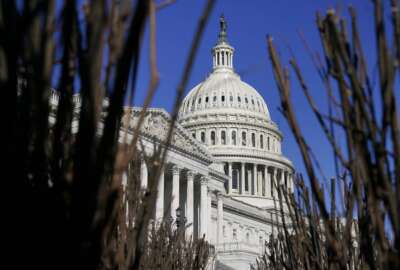
Senate passes 2022 federal spending bill, sends to Biden’s desk
The $1.5 trillion spending bill, approved almost halfway through the fiscal year, is expected to be swiftly signed into law by the president.
The Senate voted 68-31 Thursday night to pass a $1.5 trillion omnibus bill that will fund federal government agencies for the remainder of Fiscal Year 2022, following in the footsteps of the House, which passed the measure the previous evening. The bill now goes to President Biden’s desk.
The vote both avoids the prospect of government shutdowns through the end of the fiscal year on Sept. 30, and eliminates the threat of a year-long continuing resolution that federal agencies had feared.
But finally getting a spending bill that aligns with 2022 spending priorities, rather than last year’s, presents challenges of its own, considering how much time has already passed.
The government has been operating under a series of continuing resolutions for nearly five-and-a-half months, leaving agency financial and program managers relatively little time to adjust to and spend the influx of properly-aligned funding, including the new starts a full-up spending bill finally allows in the federal contracting sphere.
The omnibus measure includes discretionary spending increases for both domestic agencies and the Defense Department. On the non-Defense side, the combined increases amount to a $6.7 billion plus-up, a figure that Senate Democrats noted was the largest increase in domestic discretionary spending in the past four years.
As to the Defense budget, DoD leaders had previously estimated that a year-long CR would have left it with $20 billion less in spending power than it had the year before, partly because simply extending 2021 appropriations for another year would have left billions of dollars in accounts that don’t need and can’t spend the money. Instead, the omnibus will deliver $728.5 billion — $32.5 billion more than Congress delivered in 2021, according to the Senate Appropriations Committee.
Both chambers of Congress approved the measure despite its 2,741 pages of text having only been finalized and released on Wednesday.
“Is an omnibus appropriations bill ideal? No, it’s not,” said Sen. Richard Shelby, R-Ala., the ranking member on the Senate Appropriations Committee. “But at this critical time, and this late date, it’s necessary … I think overall, this is something we should have done six months ago.”
Sen. Patrick Leahy (D-Vt.), the Appropriations Committee chairman, said the overall measure represented a bipartisan commitment to “stand up to the needs of America.”
“But we’re also standing up for Ukraine, which is being attacked by a war criminal,” he said.
To that end, the bill also allocates $13.6 billion in funding toward military and humanitarian assistance to Ukraine — those funds are about evenly divided between the Defense and non-Defense accounts.
The final compromise House and Senate appropriators reached this week also cut back a roughly equal amount of spending the the White House wanted to spend on COVID relief.
Though White House officials initially told Congress that Biden wanted $30 billion more to continue battling COVID-19, a few days later, he formally requested a scaled-back $22.5 billion. In bargaining over a final bill with skeptical Republicans, who said Congress had already spent enough, top Democrats settled for $15.6 billion.
But Wednesday, rank-and-file House Democrats rebelled against cuts Republicans had negotiated in previously approved pandemic aid for 30 states to help pay for the new spending. Rather than delaying the entire bill, House Speaker Nancy Pelosi, D-Calif., removed all the pandemic funds. The number ended up at zero.
One factor that helped generate a final compromise was Democratic leaders’ decision to restore the practice of earmarks. This year’s bill included thousands of those projects at a price tag of several billion dollars. A decade or two ago, the numbers were often higher than that.
Just before it voted to approve the omnibus bill on Thursday, the Senate rejected an amendment by Sen. Mike Braun, R-Ind., to strip each of the earmarks from the package. The vote wasn’t close — only 35 senators sided with Braun, who said the earmarks — spending that had not been greenlit by Congress’s authorizing committees — encompassed 367 pages, weighed five pounds when printed, and showed “the swamp is rising again.”
The White House said the president looks forward to signing the appropriations package, partly because it “ends a damaging series of short-term continuing resolutions that have undermined the government’s ability to meet pressing challenges,” Jen Psaki, the White House Press Secretary said in a statement shortly after the Senate vote.
“The bipartisan funding bill proves once more that members of both parties can come together to deliver results for the American people,” she said. “It will reduce costs for families and businesses, support our economic recovery, and advance American leadership abroad. With these resources, we will be able to deliver historic support for the Ukrainian people as they defend their country and democracy, launch a bold new initiative to drive unprecedented progress in curing cancer and other diseases, and provide additional support to our law enforcement so they can protect our communities.”
The Associated Press contributed to this report.
Copyright © 2025 Federal News Network. All rights reserved. This website is not intended for users located within the European Economic Area.
Jared Serbu is deputy editor of Federal News Network and reports on the Defense Department’s contracting, legislative, workforce and IT issues.
Follow @jserbuWFED





